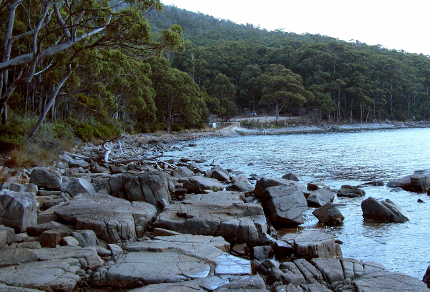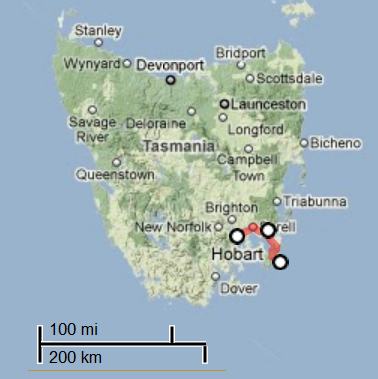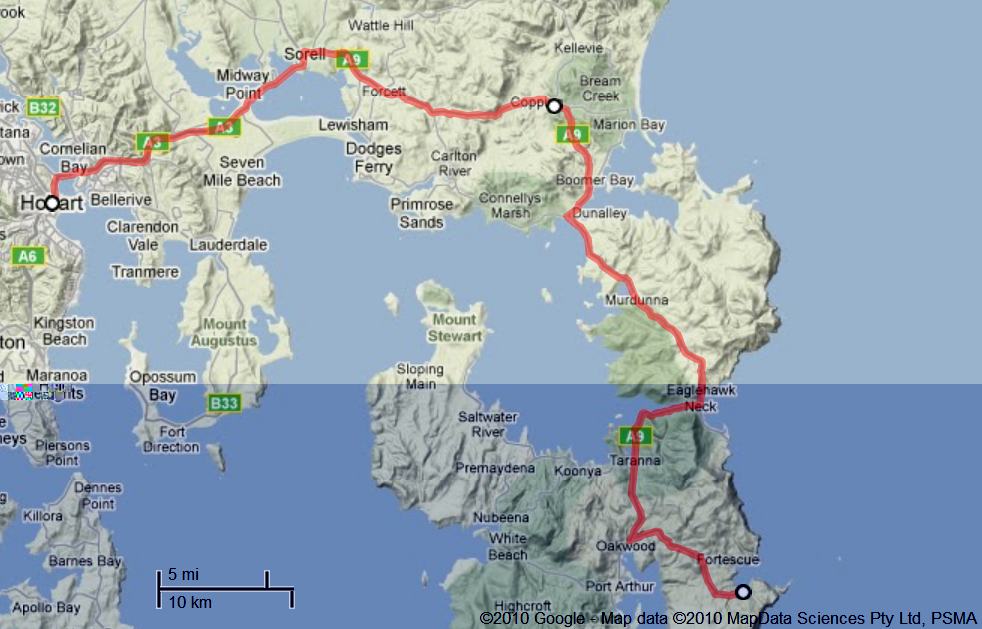In an about-face from the past five days of brilliantly sunny weather, the sky was cloudy with clear breaks over Melbourne’s Tullamarine Airport when our Jetstar flight sped down one of the airport’s runways late this morning for its hour and a quarter trip to Hobart, the capital of the state of Tasmania. After lifting into the air, we flew over the plain surrounding the airport, the flat land resembling a green patchwork of small holdings, many edged with hedgerows. The roofs of buildings in towns glinted like bits of tinsel dropped here and there in bunches, and Melbourne sprawled across the landscape to the southeast. While in the city, we’d had no feel of it being on the ocean, but we caught quick glimpses of Bass Straight from the air, before the view was dimmed by a haze of cloud.
I took with me images of the city, with its scurrying crowds, hodgepodge of stately and flamboyant architecture, its abundance of cultural venues and restful gardens. Truly multicultural and cosmopolitan, Melbourne had exuded dynamic energy and a forceful ‘look at me’ personality. It had shown us some of its down side, too – the hawking of restaurant owners that sometimes bordered on harassment, the filthiest public toilet I’ve seen anywhere in the world, with fresh urine all over the floor trickling into a drain, the taxi driver running us out to the airport with his gas tank on empty and his cab smelling of booze. His conversation had done some weaving, but fortunately, his driving hadn’t.
Our first view of Tasmania was of fields and pastures in a lowland bordered by forested uplands. At higher elevations, the forests gave way to open alpine expanses of plateau splotched with a surprising number of lakes and rivers. Rugged mountain ranges to the southwest were speckled with curds of cloud, and the ocean spread blue and vast beyond a distant west coast. Tawny rangeland spread over a rolling plain beneath the jet, and forest plantations appeared as obvious dark green, irregular patches within olive-green forest. Closer to Hobart, the mighty River Derwent snaked through a rolling landscape of tawny hills and bright green, irrigated fields, some covered with row cover fabric. “Tasmania,” Vilis murmured. “It’s one of those magical names, like Timbuktu.”
At the airport, we rented a Suzuki Alto and drove into Hobart, a hilly maritime city that reminded me greatly of Halifax, Nova Scotia, although it was much smaller. In the downtown core, the Elizabeth Street Mall was lively with restaurants that showed no sign whatsoever of the hawking we’d seen in Melbourne. After purchasing The Rough Guide to Tasmania, by James Stewart and Margo Daly, we stocked up on groceries, camp fuel, extra tent pegs, and then drove eastward out of the city, heading for Tasman National Park and its Fortescue Bay campground on the Tasman Peninsula.
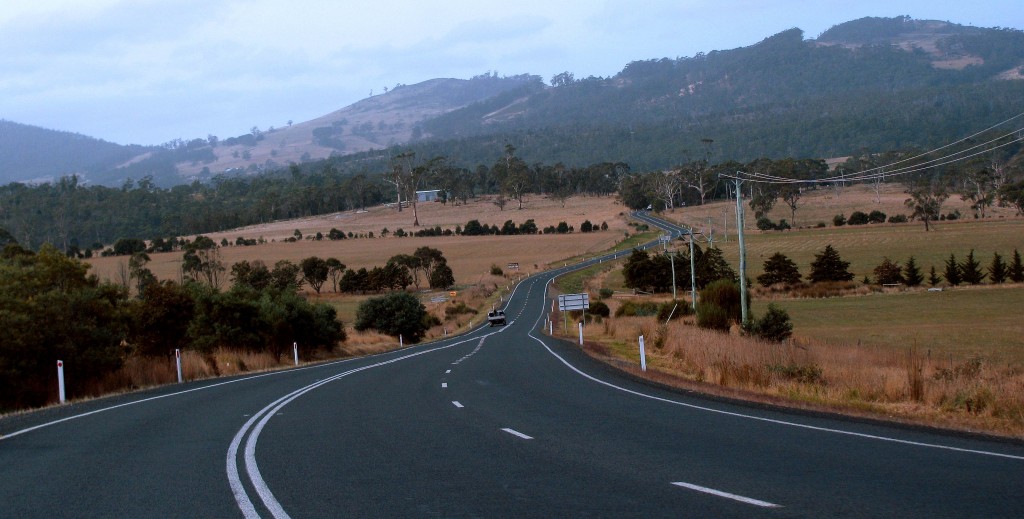
Rural Tasmania near Sorell (© Magi Nams)
Vilis drove us quickly across the Pitt Water causeway and then through tawny, rolling hills and beside walled gardens planted with roses. We passed small rural holdings, vineyards, and hay bales, with the colours of autumn pervading the landscape. Gums with pale trunks lifted broad, airy crowns against pale hillsides, their reaching, kinked limbs like a hundred arms seeking the sky.
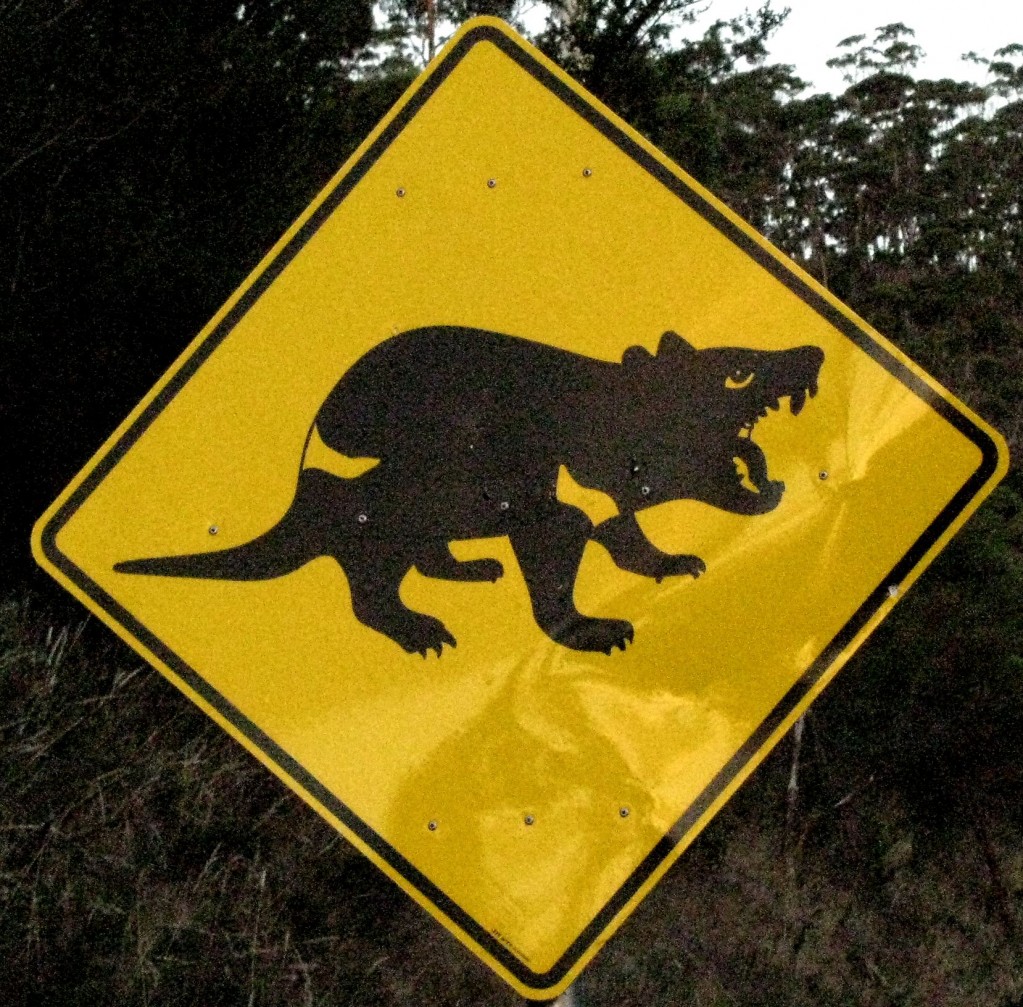
Tasmanian Devil Crossing Sign © Magi Nams)
In late afternoon, we crossed the isthmus onto Forestier Peninsula at Dunalley and encountered our first road sign warning of Tasmanian devils crossing the highway. My spirits suddenly soared. We were in devil country!
Continuing southward on the A9, we gained entrance to Tasman Peninsula through Eaglehawk Neck, an extremely narrow isthmus guarded by steep, forest-clad hills. It was Eaglehawk Neck and its military post that blocked the escape of transported convicts to mainland Tasmania from the penal colony at Port Arthur,1 20 kilometres to the south. Ten kilometres past the Neck, we passed the Tasmanian Devil Conservation Park in Taranna, and a few minutes later turned onto a gravel road that led us 10 kilometres through land managed by Forestry Tasmania, and then into Tasman National Park. Although tall trees edged the gravel in the section of road through the managed forests, making it an attractive drive, Vilis and I noted that much of the land beyond the strip of trees had been clear-felled.
Within the national park, we drove through forest to Fortescue Bay, which our travel guide described as “hauntingly beautiful” and “probably the most idyllic spot on the Tasman Peninsula.”2 With daylight soon fading, we purchased a park pass that would grant us access to all of Tassie’s national parks, paid for a campsite, and started exploring.
Near the toilet block, I grabbed Vilis’s arm, tugged him to a halt, and breathed, “There’s an echidna! In the rocks.” One of the world’s only three living species of egg-laying mammals or monotremes (the others being the platypus and long-beaked echidna)3, the short-beaked echidna looked rather like an oversized, oval sea urchin covered with brown bristles and black-tipped yellow spines. It was much larger than a hedgehog and much larger than I expected. Sensing our presence, it scuttled into a hole in a rock pile before I got a good look at its tubular beak and huge claws; nonetheless, I was thrilled to see my first monotreme in the wild. In a future blog post, I’ll discuss the three major groups of mammals – the monotremes, marsupials, and placental mammals – and the fact that the Australian region is the only place in the world where all three exist together.
Deciding to make the most of the remaining daylight, we checked out the rocky shore near our section of the campground and the start of the Cape Hauy track. As we looked out over Fortescue Bay, a white-bellied sea eagle snatched a fish from the water near a dock and began flapping away over the bay, inciting a cacophony of screeches from adult and immature silver gulls on the water and hanging around a fish-cleaning station.
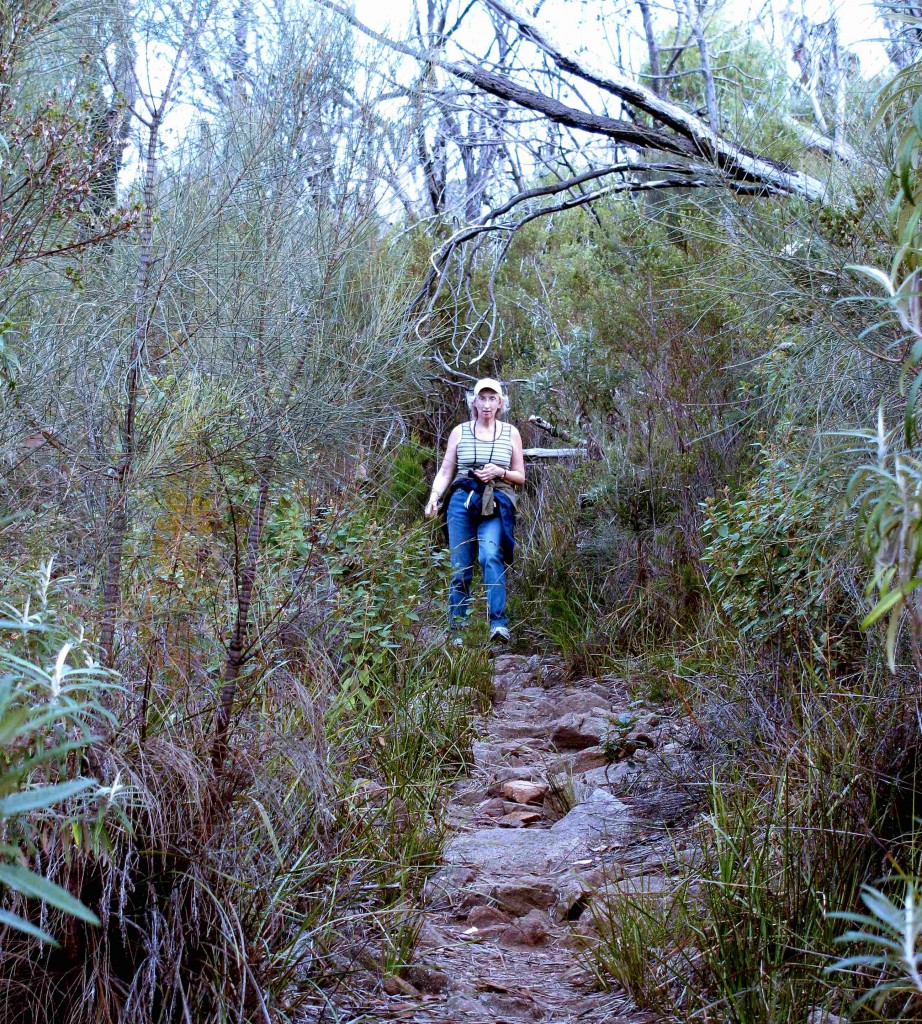
Here I’m on Cape Hauy Track above Fortescue Bay © Vilis Nams)
The Cape Hauy track initially followed the shoreline before leading us up onto steep hillsides above Fortescue Bay. It began as a rough strip of exposed stones and progressed to a continuous jumble of rock plates hard on the feet and treacherous for knees and ankles. Within a few minutes, we spooked a macropod feeding in dense vegetation next to the trail. It had a silvery-brown tail and dark face and body, with a whitish belly and rusty nape. When we returned to camp, I identified it as a red-necked wallaby, one of two large macropods occurring in Tasmania, the other being the eastern grey kangaroo.4
The vegetation growing beside the track was a tangled mixture of tall sedges, heaths, banksias and other shrubs that scratched and poked us and encroached on the trail. Fallen branches from dead trees added to the disorder, and both living and dead trees speared upward through the shrubs. Many of the dead trees were mortally scarred by fire, and as we hiked higher, the living trees became twisted and stunted from exposure to ocean winds. A stiff breeze whipped in off the Tasman Sea, with the feel that it was blowing up some weather.
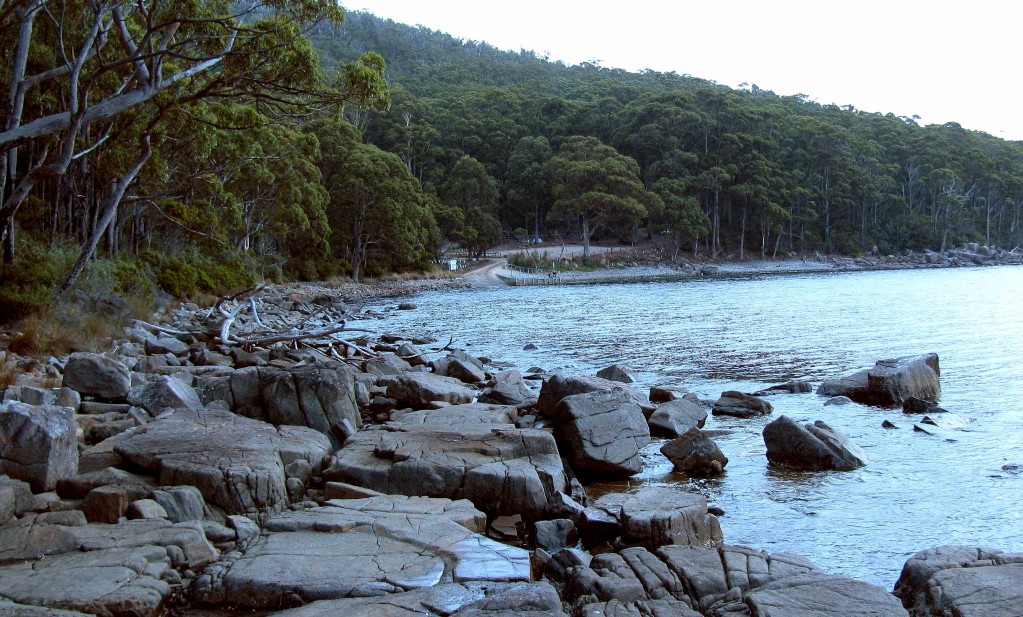
Intertidal Rock Ledges at Fortescue Bay (© Vilis Nams)
With the light quickly fading, we retraced our steps back to the shore near camp, making a short detour to stroll out onto grey intertidal rock ledges. She-oaks with weeping branchlets leaned over the rocks, and broad-bladed kelps swirled in the water offshore. The salty tang of the ocean filled the air, and Pacific gulls, also called mollyhawks, and a little pied cormorant stood like black and white sentinels near rock edges. Barnacles and limpets clung to the sides of stone slabs in surge channels, while ocean wracks with air bladders like flat, rectangular beads lay sprawled in fissures, awaiting the tide’s return.
Returning to camp, we spotted a dark, petite macropod at our site, which fit the description of a rufous-bellied pademelon. Obviously habituated to the presence of humans, it hung around our site for a few minutes and then bounded into the forest.
We set up our tent and prepared a quick supper of hot soup and buns in the light of our lantern. Then we strolled through the campground in the calm darkness, the stars overhead showing Orion tilted upside down, as though doing a handstand. After the ceaseless noise and rush of Melbourne, where we’d heard the insistent roar of traffic even in the night from our room on the hotel’s seventeenth floor, we felt ensconced within a haven of natural peace at Fortescue Bay. When we slid into our sleeping bags, we heard only the gentle lapping of waves on the shore.
Today’s fauna: white-bellied sea eagle, silver gulls, *Pacific gulls, little pied cormorant, *short-beaked echidna, *red-necked wallaby, *rufous-bellied pademelon.(*lifelist sighting)
References:
1. James Stewart and Margo Daly. The Rough Guide to Tasmania. 2008. Rough Guides, New York. p. 110; 2. Ibid, p. 112.
3. Ronald Strahan, editor. The Mammals of Australia.1995. Reed New Holland, Sydney. p. 34.
4. Peter Menkhorst and Frank Knight. A Field Guide to the Mammals of Australia. Oxford University Press, South Melbourne. pp. 118,124.

